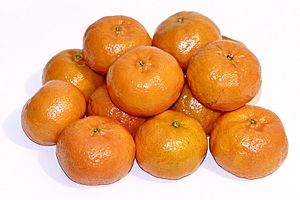Koji orange facts for kids
Quick facts for kids Koji orange |
|
|---|---|
 |
|
| Scientific classification | |
| Genus: |
Citrus
|
| Species: |
leiocarpa
|
| Forms | |
|
|
| Synonyms | |
|
|
The Koji orange (Citrus leiocarpa) is a special type of citrus fruit. It's also called the smooth-fruited orange in English. This fruit has many names in different languages, like bingyul in Korean and Kōji in Japanese. The Koji orange first came from Japan.
Contents
Where Does the Koji Orange Grow?
The Koji orange is originally from Japan. However, you can also find it growing in the United States. It's also grown in other parts of East Asia, such as South Korea and China.
What Does a Koji Orange Look Like?
The Koji orange fruit is small and round, but a little flat. It has a bright orange color and a slightly bumpy skin. This fruit ripens in the fall, usually from October through November. People have been growing it since at least the year 1900.
The Koji orange tree has many branches and a wide, round top. Its trunk is short and straight. The leaves are dark green and shaped like an oval. The fruit itself has many seeds, which is one reason it's not usually grown to be sold in stores.
How Koji Oranges Are Related to Other Fruits
Scientists believe the Koji orange is a type of hybrid. This means it's a mix of two different parent plants. It's thought to be a cross between a "koji-type" plant and the tachibana orange. The Koji orange has a similar genetic makeup to other fruits called komikan and toukan.
Different Types of Koji Oranges
One special type of Koji orange is called Citrus leiocarpa f. monoembryota. This form was first described by a scientist named Chozaburo Tanaka. For a while, people thought it was just a small change in the Koji orange. But now we know it's actually a hybrid too! It's a mix of the Koji orange and the Kishu mikan. In China, this type is known as Jun he gan zi. In Japan, it's called Suruga yukō.
Images for kids


